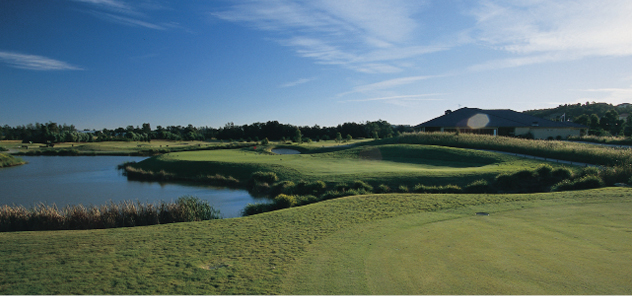 Macquarie Links INTERNATIONAL GOLF CLUB
Macquarie Links INTERNATIONAL GOLF CLUB

Shanghai, Guam, Bali, Sabah, Bangkok, Singapore, Alaska, Hawaii; American course designer Robin Nelson has spent much of the past 30 years travelling from one exotic destination to another, putting his next project in the ground. One wonders what he thought of the outer south-western suburbs of Sydney when he made his first site inspection in 1996.
In Bali, Hawaii and Guam, Nelson had the ocean as a backdrop. In Sabah he had a rainforest. At Macquarie Links there were no such distractions. Nelson’s creative nous was tested from day one by the plan to turn rolling pastoral land into a championship course and the centrepiece of a $250 million residential golf community.
With only a few pockets of trees on the proposed site, Nelson’s intention was to create a links-style course with an Australian flavour. He also wanted the course to be enjoyable for all golfers. He succeeded on both counts. While the course definitely has a links feel on many holes, several holes incorporate an Australian bush character, with native grasses and tall gum trees standing alongside fairways. The fairways are reasonably wide with strategically placed bunkers, a combination of traditional Scottish pot bunkers and the massive pits found on Melbourne’s sandbelt courses. Mounding and water hazards on several holes can also complicate the scorecard of the wayward hitter.
Macquarie Links opened for play in 2002 and the high standard of its presentation impressed from the start. The creeping bent-grass greens have always been superb, while the couch fairways have developed into some of Sydney’s best. Much of the course’s maturing has taken place off the fairways. The couch-grass rough has become tighter and more penal, while many of the saplings planted during construction have now reached a height and a width that slicers and hookers find bothersome.
The 497-metre, par-five 1st sets the tone for the round, with a generous, gently rolling fairway laid out in front of you. As you progress towards the green, the fairway narrows and the hazards become more frequent, with cross-bunkers and out-of-bounds areas to the left coming into play. Another large scheme of bunkers dominates the right edge of the fairway for the last 50 metres to the green, which is small and slopes towards the back fringe.
One aspect of Macquarie Links that makes it an enjoyable 18-hole excursion for everyone is the multiple tees available on each hole. A par-72 course, it measures 6278 metres from the championship pegs but a considerably shorter 4801 metres from the white forward markers. With two other teeing options in between, this is a course for all levels of golfer.
The teeing options are particularly helpful on some of the par-fours. The par-four 2nd, 406 metres at its longest, is a brute, especially in summer when the prevailing north-easterly breeze is in your face and your approach to the green, which has a lake alongside it, requires a long iron or fairway wood.
The back nine has some memorable offerings. The long par-three 11th calls for a 170-metre tee shot over a wide creek and on to the green, which nestles in a natural amphitheatre created by tall gums and shrub-covered mounds. It is a long way from Shanghai or Hawaii, but Nelson’s only Australian course design makes for an unforgettable experience.
Macquarie Links is a private members’ course. Access is available for interstate and overseas visitors by prior arrangement with club management.
|
MEMORABLE HOLES 1st, 2nd, 9th, 11th, 15th and 18th WHERE TO GO Macquarie Links Dr, Macquarie Links, NSW 2565 BOOK A ROUND (02) 8796 5888, www.macquarielinksgolfclub.com.au OTHER 120 GREAT COURSES NEARBY The Lakes (41.5 km), Castle Hill (43.6 km), The Australian (44.9 km), New South Wales (46.9 km) WHERE TO STAY The closest accommodation can be found in nearby Campbelltown at the stylish Rydges hotel. The course is also a 45-minute drive, via the M5 freeway, from the hotels of Sydney’s CBD. BEFORE/AFTER YOUR ROUND Australia’s largest botanical garden lies 20 minutes away. The Mount Annan Botanic Garden covers 410 hectares and boasts more than 4000 species of native plants. |